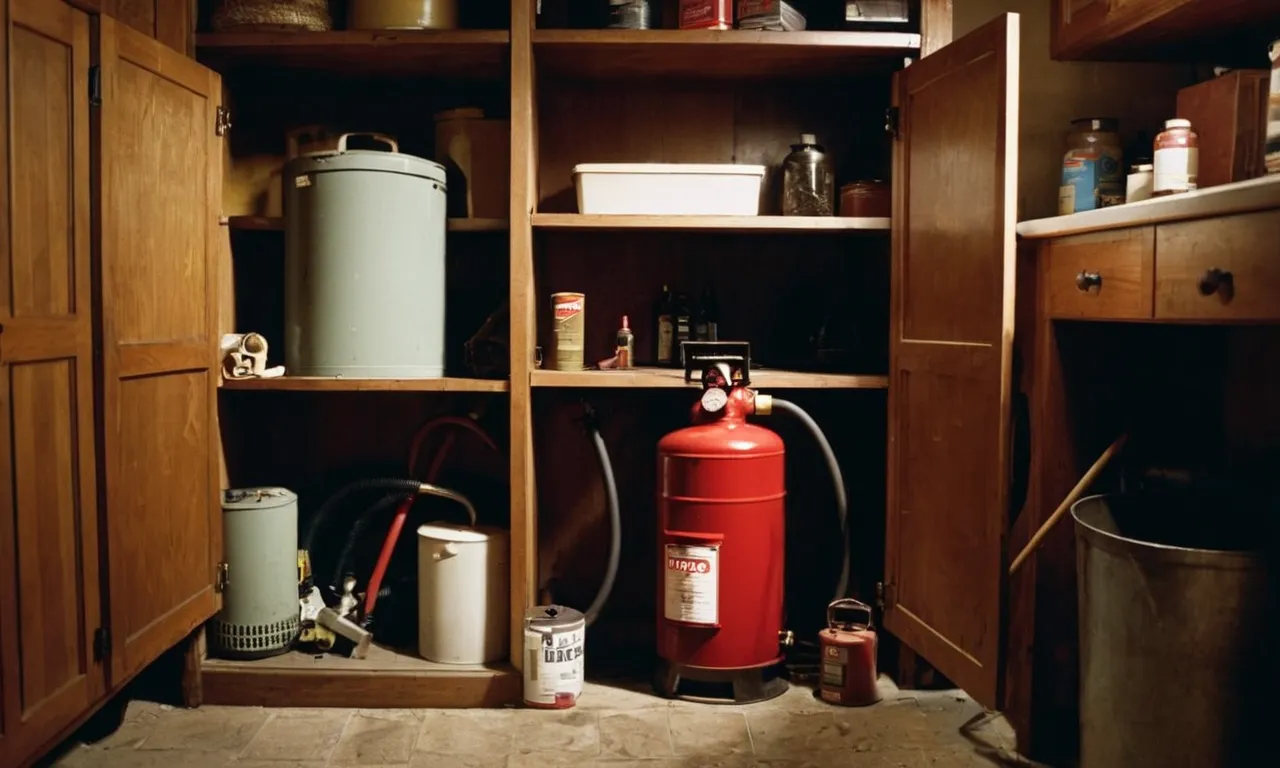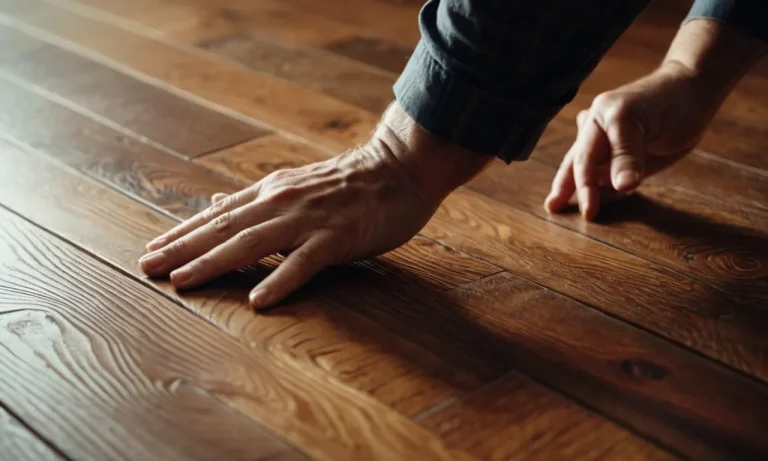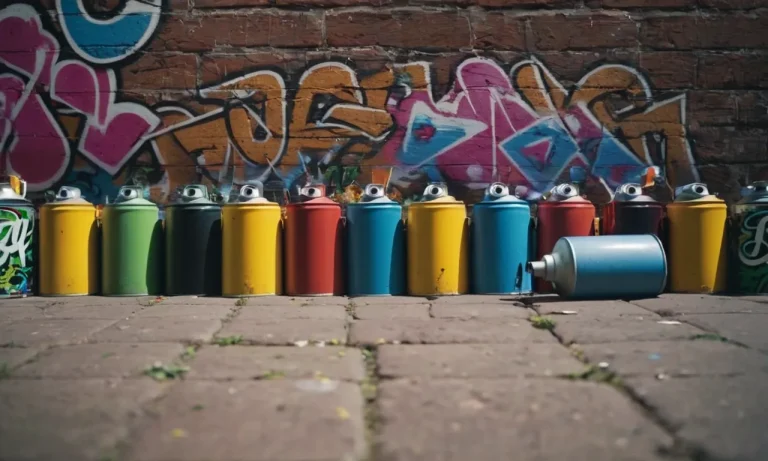Gas Water Heater Not Lighting? Here’S How To Fix It
If you turn the hot water knob but get only cold water from your faucets, you likely have an issue with your gas water heater not lighting. A gas water heater that won’t ignite can leave you without hot water when you need it most.
If you’re short on time, here’s a quick answer to your question: Check the gas valve, thermocouple, pilot light, and igniter to diagnose and fix the root cause of your gas water heater not lighting properly.
In this comprehensive guide, we’ll walk through all the possible reasons a gas water heater won’t ignite along with steps to diagnose and fix the problem yourself.
How Does a Gas Water Heater Work?
A gas water heater is a common appliance found in many households. It works by using natural gas or propane to heat and store water for everyday use. Understanding how a gas water heater works can help you troubleshoot and fix any issues that may arise.
The Basic Components of a Gas Water Heater
A gas water heater consists of several key components that work together to provide hot water. These components include:
- Tank: The tank is where the water is stored and heated. It is typically made of steel and insulated to keep the water hot.
- Burner: The burner is responsible for heating the water. It is located at the bottom of the tank and is ignited by a pilot light or electronic ignition system.
- Flue: The flue is a pipe that allows the combustion gases to escape from the water heater. It is important to ensure the flue is properly vented to prevent the buildup of harmful gases.
- Thermostat: The thermostat controls the temperature of the water. It is usually located on the front of the water heater and can be adjusted to your desired temperature.
- Dip Tube: The dip tube is responsible for delivering cold water to the bottom of the tank. This ensures that the hot water is always available at the top of the tank.
The Lighting Sequence
To understand how to fix a gas water heater that is not lighting, it is important to know the lighting sequence. Here is a step-by-step guide:
- Pilot Light: The first step is to check if the pilot light is lit. If it is not, follow the manufacturer’s instructions to relight it. If the pilot light keeps going out, there may be an issue with the thermocouple or gas valve.
- Main Burner: Once the pilot light is lit, the main burner should ignite when hot water is needed. If the main burner does not ignite, there may be a problem with the gas supply, igniter, or control valve.
- Temperature Adjustment: If the pilot light and main burner are functioning properly, but the water is not hot enough, you may need to adjust the temperature setting on the thermostat.
It is important to note that working with gas appliances can be dangerous. If you are unsure or uncomfortable with troubleshooting a gas water heater, it is best to contact a professional plumber for assistance.
For more information on gas water heaters and troubleshooting tips, you can visit www.energy.gov or www.thisoldhouse.com.
Common Reasons a Gas Water Heater Won’t Light
Pilot Light is Out
One of the most common reasons a gas water heater won’t light is because the pilot light has gone out. The pilot light is a small flame that ignites the gas burner, allowing the water heater to heat up. If the pilot light is out, you can relight it by following the manufacturer’s instructions.
Typically, this involves turning the gas control valve to the pilot position, pressing and holding down the reset button or igniter, and using a match or lighter to ignite the pilot light. If the pilot light continues to go out, there may be an issue with the thermocouple.
Thermocouple Malfunction
The thermocouple is a safety device that detects whether the pilot light is lit. If the thermocouple is malfunctioning, it may not be sending the proper signal to the gas valve, causing the gas water heater to not light. In this case, the thermocouple may need to be replaced.
It is recommended to consult a professional plumber or the manufacturer’s instructions for guidance on replacing the thermocouple.
Gas Valve or Solenoid Issues
If the pilot light is lit but the gas water heater still won’t light, there may be an issue with the gas valve or solenoid. The gas valve controls the flow of gas to the burner, while the solenoid is responsible for opening and closing the gas valve.
If either of these components is faulty or damaged, they may need to be repaired or replaced by a professional.
Igniter Problems
The igniter is responsible for creating a spark to ignite the gas burner. If the igniter is not functioning properly, it may not be able to create the spark needed to light the gas water heater. This can be due to a faulty igniter or a problem with the electrical connection.
In some cases, cleaning or adjusting the igniter may solve the issue. However, if the igniter is damaged, it may need to be replaced.
Insufficient Gas Flow
If there is insufficient gas flow to the water heater, it may not light or stay lit. This can be caused by a variety of factors, including a closed gas valve, a gas leak, or low gas pressure. It is important to check that the gas valve is fully open and that there are no visible signs of a gas leak.
If the issue persists, it is recommended to contact a professional plumber for further assistance.
Sediment Buildup
Sediment buildup in the water heater can also prevent it from lighting. Over time, minerals and debris can accumulate at the bottom of the tank, obstructing the burner and causing ignition problems. Flushing the water heater to remove the sediment can help resolve this issue.
It is recommended to follow the manufacturer’s instructions or consult a professional plumber for proper flushing techniques.
Thermostat Failure
If the thermostat on the gas water heater is not working correctly, it may not signal the burner to light up. This can result in a water heater that won’t light or heat the water to the desired temperature.
If you suspect a thermostat failure, it is best to contact a professional plumber to diagnose and replace the faulty thermostat.
How to Diagnose the Root Cause
If your gas water heater is not lighting, it can be frustrating and inconvenient. However, before calling a professional, there are a few steps you can take to diagnose the root cause of the problem. By following these steps, you may be able to fix the issue yourself and save some money in the process.
Inspect the Pilot Light
The first thing you should check is the pilot light. The pilot light is a small flame that ignites the gas burner. If it is out, you will need to relight it. Follow the manufacturer’s instructions to relight the pilot light safely.
If the pilot light keeps going out or won’t stay lit, there may be an issue with the thermocouple.
Check the Thermocouple
The thermocouple is a safety device that detects whether the pilot light is lit. If the thermocouple is faulty, it may not allow gas to flow to the burner. Inspect the thermocouple to ensure it is properly positioned and free from dirt or debris.
If it is damaged or worn out, it will need to be replaced.
Test the Gas Valve
The gas valve controls the flow of gas to the burner. If the gas valve is faulty, it may not open properly, preventing the burner from igniting. Check the gas valve to ensure it is in the correct position and free from any obstructions. If the gas valve is damaged, it will need to be replaced.
Verify Igniter Function
The igniter is responsible for creating a spark to ignite the gas burner. If the igniter is not functioning properly, it will not be able to light the gas. Inspect the igniter for any signs of damage or wear. If it is faulty, it will need to be replaced.
Ensure Adequate Gas Flow and Pressure
Low gas flow or pressure can prevent the burner from igniting. Check the gas supply to ensure it is turned on and that there are no blockages or leaks in the gas line. If the gas flow or pressure is too low, you may need to contact your gas supplier to resolve the issue.
Check for Sediment Buildup
Sediment buildup in the tank can affect the performance of the gas water heater. Over time, minerals in the water can settle at the bottom of the tank, hindering the burner’s ability to ignite. Drain and flush the tank to remove any sediment buildup.
Regular maintenance can help prevent this issue from occurring.
Test the Thermostat
The thermostat controls the temperature of the water in the tank. If the thermostat is not functioning correctly, it may not signal the gas valve to open and ignite the burner. Test the thermostat by adjusting the temperature setting and listening for the sound of the gas igniting.
If the burner does not ignite, the thermostat may need to be replaced.
Remember, if you are unsure about diagnosing or fixing the problem yourself, it’s always best to consult a professional. They have the knowledge and experience to handle any issues with your gas water heater safely and effectively.
Fixing a Gas Water Heater That Won’t Light
Relighting the Pilot
If your gas water heater is not lighting, the first thing you should check is the pilot light. The pilot light is a small flame that ignites the gas burner when the water temperature drops below the set point. Sometimes, the pilot light may go out due to a draft or other issues.
To relight the pilot, follow these steps:
- Locate the pilot light assembly. It is usually found near the bottom of the water heater.
- Turn the gas control knob to the “Off” position and wait for a few minutes for any accumulated gas to dissipate.
- Turn the gas control knob to the “Pilot” position and press it down. While holding it down, use a long lighter or match to ignite the pilot light.
- Keep holding the gas control knob down for about 30 seconds, then release it. The pilot light should stay on.
- If the pilot light goes out again, it may indicate a more serious problem and you should call a professional plumber.
Replacing the Thermocouple
If the pilot light goes out immediately after releasing the gas control knob, the thermocouple may be faulty. The thermocouple is a safety device that shuts off the gas supply if it senses that the pilot light is not lit. To replace the thermocouple:
- Turn off the gas supply to the water heater.
- Remove the burner access panel to access the thermocouple.
- Disconnect the thermocouple from the gas control valve.
- Install the new thermocouple by connecting it to the gas control valve.
- Reassemble the burner access panel and turn on the gas supply.
Cleaning or Replacing the Burner Assembly
If the pilot light stays lit but the burner does not ignite, the burner assembly may be dirty or damaged. Over time, dirt and debris can accumulate on the burner, preventing gas flow and ignition. To clean or replace the burner assembly:
- Turn off the gas supply to the water heater.
- Remove the burner assembly, following the manufacturer’s instructions.
- Clean the burner with a brush and remove any debris or obstructions.
- If the burner is damaged, replace it with a new one.
- Reinstall the burner assembly and turn on the gas supply.
Clearing Obstructions in Gas Line
If the pilot light and burner are both functioning properly, but the water heater still won’t light, there may be an obstruction in the gas line. Debris or a blockage can prevent the gas from reaching the burner. To clear obstructions:
- Turn off the gas supply to the water heater.
- Disconnect the gas line from the burner assembly.
- Use compressed air or a wire brush to clean out any debris or obstructions.
- Reconnect the gas line and turn on the gas supply.
Replacing Gas Valve or Solenoid
If none of the above steps solve the problem, there may be an issue with the gas valve or solenoid. These components control the flow of gas to the burner. Replacing the gas valve or solenoid is a complex task and should be done by a qualified professional.
If you’re not comfortable working with gas appliances, it’s always best to call a licensed plumber or HVAC technician to diagnose and fix the issue.
Cleaning Out Sediment
Sediment buildup in the bottom of the water heater tank can also cause issues with the burner and ignition. Over time, minerals and debris can settle at the bottom of the tank, reducing the efficiency of the water heater. To clean out sediment:
- Turn off the gas supply to the water heater.
- Connect a garden hose to the drain valve at the bottom of the tank.
- Open a hot water faucet in the house to relieve pressure.
- Open the drain valve and let the tank drain completely.
- Close the drain valve and refill the tank.
- Turn on the gas supply and relight the pilot light.
Replacing Thermostat
If the water heater still won’t light after trying all the above steps, the thermostat may be faulty. The thermostat controls the temperature of the water and signals the gas valve to open when the temperature drops below the set point. To replace the thermostat:
- Turn off the gas supply to the water heater.
- Remove the thermostat cover and disconnect the wires.
- Remove the old thermostat and install the new one, following the manufacturer’s instructions.
- Reconnect the wires and replace the thermostat cover.
- Turn on the gas supply and relight the pilot light.
Remember, gas appliances can be dangerous if not handled properly. If you’re unsure about any of these steps or if you’re unable to fix the issue, it’s always best to seek professional help. A licensed plumber or HVAC technician will have the expertise to diagnose and repair the problem safely.
When to Call a Professional
While there are some common issues that can be easily fixed when your gas water heater is not lighting, there are certain situations where it is best to call a professional. Here are a few instances when you should consider reaching out to a licensed plumber or HVAC technician:
1. Gas Leaks:
If you suspect a gas leak, it is crucial to call a professional immediately. Gas leaks are extremely dangerous and can lead to explosions or carbon monoxide poisoning. A trained technician will have the necessary equipment and expertise to safely detect and repair the leak.
2. Electrical Problems:
If you notice any electrical issues, such as sparks or burning smells coming from your water heater, it is best to leave it to the professionals. Dealing with electricity can be hazardous, and attempting to fix electrical problems without proper knowledge and experience can result in injury or further damage to your equipment.
3. Complex Repairs:
If you have tried basic troubleshooting steps and your gas water heater still won’t light, it may indicate a more complex issue. Some problems, such as a faulty thermocouple or a malfunctioning gas valve, require specialized knowledge and tools to diagnose and fix.
In such cases, it is recommended to hire a professional who has the expertise to handle these repairs effectively.
4. Manufacturer’s Warranty:
If your gas water heater is still under warranty, attempting to fix it yourself may void the warranty. It is advisable to check the terms and conditions of your warranty and consult with a professional authorized by the manufacturer to carry out any repairs or replacements.
Remember, safety should always be the top priority. If you are unsure about how to proceed or if the issue seems beyond your capabilities, it is always better to seek professional help. Hiring a licensed plumber or HVAC technician will not only ensure the problem is resolved correctly but also give you peace of mind knowing that your gas water heater is functioning safely and efficiently.
For more information on gas water heater repairs and maintenance, you can visit www.homeadvisor.com or www.angieslist.com.
Preventative Maintenance
Regular maintenance is key to keeping your gas water heater in good working condition. By taking a few simple steps, you can prevent issues and ensure that your heater continues to provide you with hot water when you need it. Here are some important maintenance tasks you should perform regularly:
Regularly Check Pilot Light
The pilot light is responsible for igniting the gas burner in your water heater. If the pilot light goes out, your water heater won’t be able to produce hot water. To prevent this from happening, it’s important to regularly check the pilot light and make sure it is lit.
You can do this by removing the access panel and looking for a small flame. If the pilot light is out, follow the manufacturer’s instructions to relight it.
Replace Thermocouple Annually
The thermocouple is a safety device that detects whether the pilot light is lit. If it detects that the pilot light has gone out, it automatically shuts off the gas supply to prevent a dangerous gas leak. Over time, the thermocouple can wear out and become less effective.
To ensure that it continues to function properly, it’s recommended to replace the thermocouple annually. This is a simple task that can be done by following the manufacturer’s instructions.
Flush Tank and Inspect Anode Rod
Sediment can build up in the tank over time, reducing the efficiency of your water heater. To prevent this, it’s important to flush the tank regularly. This involves draining the tank and removing any sediment that has accumulated.
Additionally, it’s a good idea to inspect the anode rod during this process. The anode rod helps prevent corrosion inside the tank. If it is worn out, it should be replaced to ensure the longevity of your water heater.
Keep Gas Valve Clear of Dust and Debris
The gas valve controls the flow of gas to your water heater. If it becomes clogged with dust and debris, it can prevent the burner from lighting properly. To avoid this issue, make sure to keep the gas valve clean and free of any obstructions.
You can do this by gently blowing compressed air into the valve or using a soft brush to remove any buildup.
By regularly performing these maintenance tasks, you can keep your gas water heater in optimal condition and avoid issues with the pilot light not lighting. Remember to always refer to the manufacturer’s instructions for specific maintenance guidelines and safety precautions.
Conclusion
If your gas water heater isn’t lighting, methodically go through each component like the pilot light, thermocouple, gas valve, igniter, and thermostat to isolate the problem. In many cases, you can take steps like relighting the pilot or replacing simple parts to get your hot water heater running again.
With regular maintenance like annual flushing and thermocouple replacement, you can avoid many ignition issues and extend the life of your water heater. But if you determine the root cause is beyond DIY repair, don’t hesitate to call a professional for assistance.
With the right diagnosis process, you can get your gas water heater lighting properly and enjoy endless hot water again.







